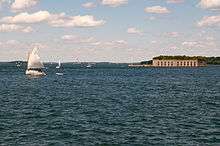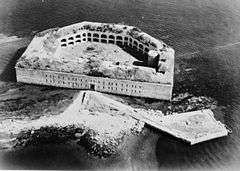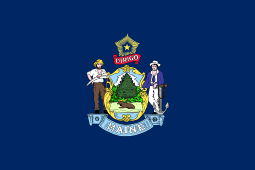Fort Gorges
|
Fort Gorges | |
|
Fort Gorges | |
  | |
| Location | E of Portland on Hog Island, Portland Harbor |
|---|---|
| Nearest city | Portland, Maine |
| Coordinates | 43°39′47″N 70°13′17″W / 43.66306°N 70.22139°WCoordinates: 43°39′47″N 70°13′17″W / 43.66306°N 70.22139°W |
| Area | 6 acres (2.4 ha) |
| Built | 1858 |
| NRHP Reference # | 73000114[1] |
| Added to NRHP | August 28, 1973 |
Fort Gorges is a former United States military fort built on Hog Island Ledge in Casco Bay, Maine. Built from 1858 to 1864, no battles were fought there and no troops were stationed there. Advancing military technology, including iron clad ships and long range guns, made the fort obsolete before it could be used. The fort is now a park, accessible only by boat. It was added to the National Register of Historic Places in 1973.[2]
History

Following the War of 1812, the United States Army Corps of Engineers proposed that a fort be built on Hog Island Ledge, in Casco Bay at the entrance to the harbor at Portland, Maine. Named for the colonial proprietor of Maine, Sir Ferdinando Gorges, it was constructed to support existing forts, including Fort Preble in South Portland and Fort Scammel built on nearby House Island in 1808. Congress, however, did not fund construction of Fort Gorges until 1857. The walls of the fort were begun the next year, and when the American Civil War broke out in 1861, work quickly advanced.
The fort was designed by Colonel Reuben Staples Smart. The chief architect in charge of construction was Thomas Lincoln Casey, who later became Chief of Engineers. It is similar in size and construction to Fort Sumter, but is built of granite instead of brick.
The fort was completed in 1865 as the war ended. Modern explosives made the fort obsolete by the time it was completed. A modernization plan was begun in 1869, but funding was cut off in 1876, with the third level of the fort still unfinished. During the modernization project, sod-covered sand was added to the top level of the fort to protect gun encasements and powder magazines from attacks.
The Fort's armament consisted of thirty-four 10-inch Rodman guns mounted in the fort's casemates. In 1898, all guns were removed from the fort except a large 10-inch Parrott rifle which was emplaced on the top of the fort. The 10-inch Parrott rifle still remains in place and is one of the largest surviving specimens of Civil War vintage artillery.
The fort was last used by the Army during World War II, when it was used to store submarine mines.
It was acquired by the city of Portland in 1960 and placed on the National Register of Historic Places in 1973. It is now open to the public as a park, and is accessible only by private boat. Visitors are recommended to carry a flashlight to enter the powder magazines. The fort is in need of restoration.[3]
See also
References
- ↑ National Park Service (2010-07-09). "National Register Information System". National Register of Historic Places. National Park Service.
- ↑ Richard D. Kelly (June 1973). "National Register of Historic Places Places Inventory - Nomination Form: Fort Gorges" (PDF). National Park Service. Retrieved January 19, 2016. Accompanying two photos from 1973.
- ↑ Russell, Eric (June 22, 2015). "Nonprofit group hopes to restore Fort Gorges in Casco Bay". Portland Press Herald. MaineToday Media. Retrieved January 19, 2016.
- This article contains public domain text from "Fort Scammel and Fort Gorges, Maine". U.S. Senate: Art & History Home. Retrieved 2005-12-28.
- This article contains public domain text from "Fort Gorges, Hog Island Ledge, Portland Harbor, Portland, Cumberland County, ME". Historic American Buildings Survey. Retrieved 2005-12-28.
- "Fort Gorges". Geographic Names Information System. United States Geological Survey. Retrieved 2009-02-13.
External links
 Media related to Fort Gorges at Wikimedia Commons
Media related to Fort Gorges at Wikimedia Commons- Friends of Fort Gorges Website
- Article and photos of the fort - Fort Tours
- Article and photos of the fort

